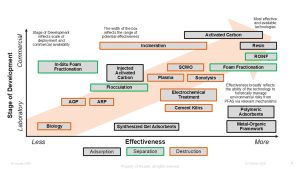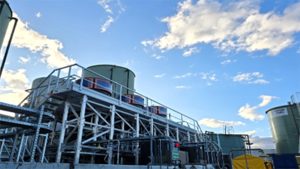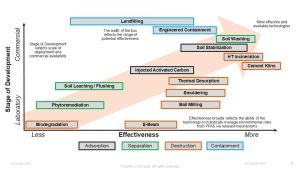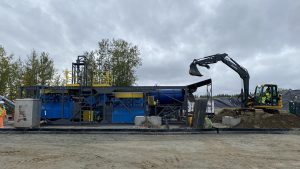The scale of PFAS contamination is a complex emerging issue, but there are holistic solutions to rise to the challenge.
Per- and polyfluoroalkyl substances (PFAS) are a group of emerging contaminants with unique properties that have become one of the defining technical and societal challenges of this generation. They are a broad class of synthetic chemicals that, for decades, have been used in a wide range of manufacturing and consumer products for their oil, water, and heat-resistant properties. The use of firefighting foams containing PFAS is commonly associated with releases into the environment, but environmental impacts can also arise via emissions from PFAS manufacturing and industrial uses, landfills, wastewater biosolids applications, and, unfortunately, much more.
The emerging reality of PFAS contamination
The widespread detections within the environment and human blood, alongside links to a range of adverse human health impacts of certain PFAS, have substantially increased the awareness and scrutiny of this class of chemicals. Regulatory agencies around the world are increasingly developing restrictions on PFAS use and setting regulatory limits for PFAS in drinking water, industrial discharges, and the environment. While initial focus has been on two legacy compounds, perfluorooctane sulfonate (PFOS) and perfluorooctanoic acid (PFOA), there is a clear overall trend towards restricting more PFAS, including those that are replacements for legacy compounds.
In the US, some state agencies are casting wider regulatory nets to include more PFAS, and there are non-government organisations and interest groups encouraging agencies to regulate all PFAS. In the European Union (EU) and the UK, restrictions on non-essential or ‘widely dispersive’ uses of PFAS are underway to address emissions in our environment and reduce the reliance on treatment. Such restrictions are complex and require balancing risks with socioeconomic factors, but can also be a driver for innovation and green technologies.
Concerns have been raised regarding uncertainties in PFAS toxicology, and as the scientific understanding and regulations regarding PFAS evolve, any future changes could have major impacts on multiple sectors. Proactive, robust, and sustainable PFAS risk management is now becoming a strategic priority across company boardrooms to address not only legacy issues but also provide resilience across supply chains for future operations.
The PFAS treatment challenge
The properties that make PFAS so useful, such as resistance to degradation, non-reactivity, and surface activity, are often the same properties associated with their widespread presence and the challenges associated with their management and treatment. Their persistence means shallow soil contamination can be present decades after original use, and their mobility means groundwater impacts can be found at significant distances from the site and point source release.
Understanding PFAS chemistry and environmental behaviour is essential to fully evaluating treatment technologies and ensuring comprehensive, future-proofed solutions. This is becoming increasingly relevant as regulatory limits become increasingly lower and more difficult and expensive to meet.
Robust site characterisation requires that the latest global understanding, tools, and guidance on PFAS be incorporated into existing approaches. This allows the implementation of PFAS site management to be pragmatic and risk-based. An example of this is looking outside the site boundary to establish background levels to place any PFAS detections in context, focus action, and help determine achievable remediation endpoints. Clients and their representatives need to understand how PFAS might have been used previously by other parties off-site and where the source areas might be located. Every site is unique and has its own history, which must be investigated with PFAS forensics tools increasingly employed to characterise and distinguish different sources versus background.
PFAS treatment approaches
The development and optimisation of PFAS treatment technologies involves multiple stakeholders. Many universities, consultants, and technology companies are vying to create a game-changing treatment technology. The PFAS challenge is too dynamic to solve in silos. It will take a combination of solutions to cost-effectively manage PFAS. Recognising there is no one-size-fits-all treatment for PFAS-impacted waste, soil, drinking water, and natural water, stakeholders are collaborating on research and development (R&D). Even industry competitors are forming alliances to accelerate progress on PFAS treatment. Academic and industry experts are exploring new technologies that can cost-effectively separate and concentrate PFAS.
The current state of the practice for PFAS remediation is a treatment train concept, primarily focused on reducing the treatment volume by concentrating the PFAS to be destroyed. This reduces the volume of waste requiring expensive treatment and/or destruction, which better matches the capabilities of these technologies. For water treatment, PFAS may be concentrated through adsorption or separation-based technologies: those technologies that exploit electrostatic and/or hydrophobic adsorption, partitioning to the gas/liquid interface, or separation using membranes.
Within the last few years, the PFAS destruction technology market has expanded significantly, offering new options for PFAS-impacted residuals and concentrate management in addition to traditional disposal means (e.g., permitted landfills, solidification, deep well injection). Selecting a destruction technology for PFAS-impacted waste management prevents the material from re-entering the environment (e.g., via landfill leachate) and eliminates long-term liability for the waste owner. Due to the high strength of the carbon-fluorine bond, destroying PFAS is very energy-intensive, and some accepted destruction processes carry risks of producing by-products. There are over a dozen (and counting) distinct destruction technologies available, with multiple vendors implementing their own types of each technology. These technologies span a range of commercial readiness from bench-scale with limited case studies, to rigorous testing at the bench, pilot, and commercial-scale. Additionally, most of these technologies have a ‘sweet spot’ and are best suited to treat certain waste types, PFAS types, or flow rates/volumes, with limitations for other matrices (bulk water chemistry). As more destruction technology vendors enter the market, it can be important to perform a third-party independent review of vendor offerings to ensure it is the most appropriate, cost-effective, and holistic PFAS solution.
PFAS water treatment
Fig. 1 provides an evaluation of the spectrum of the developmental stage and relative treatment effectiveness of select relevant water treatment and destruction technologies for managing PFAS-impacted water and highlights adsorption, separation, and destruction technologies. Activated carbon, for example, is in the top right-hand corner of the figure as it is a well-proven, effective, and commercialised option for treating certain PFAS that continues to be optimised, but it does require management and replacement of the spent/exhausted carbon when adsorption capacity is reached.

Foam fractionation (FF), for PFAS treatment, is one technology example that has seen significant development over the past few years in various industries and is now being offered by multiple vendors with varying designs and operations. FF is a separation technology that uses micron-sized gas (air or ozone) bubbles to remove emerging contaminants, such as PFAS, from water. PFAS molecules have properties attracting them to the gas-liquid interfaces present in fractionation as the injected gas bubbles move through water. FF exploits the tendency of PFAS to partition to the gas-liquid interface, concentrating them in a resultant foam. The concentrated foam is physically separated from the treated water, achieving a reduction in the contaminated volume. FF can be effective as a stand-alone technology for variable flow rate applications and as an integral part of a treatment train for minimising waste disposal costs by further reducing the volumes of high-concentration waste streams from membrane exclusion and filtration technologies. The volume reduction of a contaminant-impacted waste stream can be greater than 99% with FF, reducing treatment costs significantly. The concentrated foamate can also be managed further with destruction technologies such as supercritical water oxidation (SCWO), plasma, electrochemical treatment, and others to eliminate PFAS from the disposal cycle.

Foam fractionation technology has shown promising results across various scenarios:
Industrial wastewater: Manufacturing facilities and airports have successfully implemented foam fractionation to treat PFAS-contaminated wastewater streams.
Municipal treatment: Water utilities are exploring this technology as a cost-effective addition to their treatment processes (wastewater, landfill leachate, RO reject).
Remediation projects: Environmental cleanup projects are utilising foam fractionation for its ability to handle high PFAS concentrations.
Further research and development into PFAS water treatment and destruction technologies is a fast-moving area, and therefore, the latest information is required, evaluating robust lines of evidence with the appreciation that further breakthroughs are possible in the future. A forward-looking approach should be taken, as far as practicable, considering current trends in regulations and PFAS management to minimise the risk of treatment works being considered insufficient in the future.
PFAS soil treatment
In relation to PFAS soil remediation, while there continues to be research and development, there currently appears to be no new silver bullet technology, but instead a focus on optimising existing technologies to broaden their application whilst improving treatment performance. There is a growing understanding that it is not generally practicable, cost-effective, or sustainable to incinerate PFAS-impacted soils, and there are long-standing concerns regarding how effectively PFAS are managed in landfill leachates and thus whether this could represent a future liability. Therefore, there is an urgent need for the adoption of more sustainable, cost-effective soil remediation options.
Over recent years, soil washing and soil stabilisation/solidification (S/S) have emerged to become the most established and most implemented soil remediation technologies, with an increasing number of full-scale projects indicating greater regulatory acceptance alongside favourable costs and sustainability aspects compared to thermal approaches.
Soil washing is undertaken within large, specialised facilities that aggressively wash and disaggregate soils such that PFAS are transferred into the wash water, leaving cleaned sand and gravel, which can typically be beneficially reused, and a residual fines fraction. Wash water is recirculated and treated often using activated carbon and/or ion exchange resins.
S/S involves both chemical stabilisation (fixation) and often physical solidification of soil by mixing the soil with reagents to reduce PFAS leachability. PFAS are not destroyed during S/S but remain stabilised, and so focus has been on attempting to demonstrate and monitor long-term leaching reduction and durability. The approach is more accepted in countries with a track record in using S/S for heavy metal remediation (like the UK and US), but it is being adopted more widely and can be integrated within development programmes, including as a pre-treatment stage prior to landfilling (e.g. in Sweden and Germany).

Thermal soil remediation approaches are under significant development, mainly focused on ex-situ applications (e.g., within engineered or containerised ‘thermopiles’) to overcome challenges with achieving sufficient and even heating in the subsurface. Demonstrating effective vapour control and treatment is key to building confidence in these approaches, as well as gaining regulatory approvals.
A more novel approach is ball milling, which utilises high-energy collisions within planetary or horizontal ball mills to destroy PFAS. The technology has, at present, been demonstrated at laboratory and field scale pilot applications, but not at full scale, with significant development efforts underway.
Regardless of the approach, every technology has its limitations and constraints. For example, short-chain PFAS are often more challenging for S/S, and cohesive soils are more challenging for soil washing. While technologies may achieve very high levels of PFAS treatment, even relatively low levels of residual PFAS may not meet increasingly low regulatory thresholds. Therefore, early stage agreement of achievable, risk-based targets can ensure beneficial action is taken promptly whilst also remaining cost-efficient and sustainable.

Insights and highlights to PFAS management
Any PFAS treatment approach must be based on a robust PFAS site-specific conceptual site model (CSM) to appropriately target pollutant linkages and to deploy technologies effectively and pragmatically. This should involve the synergistic integration of any treatment within the wider site and project context, considering groundwater, stormwater, and wastewater management as well as the management of other materials and wastes. Practitioners should keep a strong focus on holistic PFAS treatment, intelligent site-specific remediation design, and effective characterisation and targeting of contamination. It is also important to remain technology agnostic and ensure critical evaluation of any new technologies, ensuring multiple lines of evidence demonstrate holistic treatment. When considering potential PFAS risks and the potential requirements for treatment at a site, a pragmatic, holistic approach includes several factors, such as:
The current and future regulatory environment, as well as stakeholder considerations.
Establishing PFAS usage and release history from document review and staff interviews.
The environmental sensitivity site, including other potential PFAS sources and available information on PFAS anthropogenic ‘background’ concentrations.
Location relative to private and public drinking water supplies, surface water, and sensitive ecological receptors, and available PFAS data associated with these potential receptors.
PFAS remediation for legacy contamination forms just one part of the response. As a society, while water treatment and hotspot remediation for PFAS are expanding rapidly across the globe, we cannot afford or sustainably rely on treatment alone. Restrictions on PFAS uses are complex and require balancing risks with socioeconomic factors, but can reduce the requirements for treatment and be a driver for innovation and green technologies.
Industry, researchers, regulators, airports, and water utilities are all grappling with how to manage PFAS, and it is now becoming a strategic priority to address not only legacy issues but also provide resilience across supply chains for future operations. Here are four keys to planning for PFAS management:
Being proactive
Assess potential risks related to PFAS by desktop evaluations of potential historical PFAS usage, vulnerabilities, receptors, and liabilities prior to sampling or testing.
Remaining pragmatic
Prioritise actions at sites most likely to impact drinking water supplies. Monitoring and implementing strategies that prevent PFAS from migrating to water supplies is the most prudent approach to managing these sensitive sites.
Prioritising agility
Regulations around PFAS are evolving, as are approaches to managing this issue. As your organisation implements interim measures, consider this evolving context to develop a flexible risk management or remediation strategy.
Embracing collaboration
Companies, researchers, regulators, federal agencies, and the water sector must combine strengths and share lessons learned to accelerate progress. There will not be a single treatment strategy for all PFAS impacts, and collaboration is more likely to produce a range of options that can be tailored to individual sites.
As the PFAS topic has gained greater public and media attention, calm and clear communication of risk and of data-driven approaches can be hugely important in addressing public concern, demonstrating robust action, and developing stakeholder-led strategies. We must always focus on the communities and people we work with on PFAS management because, in many ways, we are all in this together.

Arcadis experience
Arcadis has been working in partnership with its clients both nationally and internationally to address these contaminants since 2004, when we performed the first-ever site-specific environmental risk assessments for PFAS. Since that time, Arcadis has invested two decades in helping clients in the federal, industrial, commercial, and municipal markets treat PFAS. Arcadis staff have PFAS treatment expertise in granular activated carbon (GAC), ion exchange (IX), reverse osmosis (RO), foam fractionation (FF), and novel sorbents, among many other emerging destruction technologies. Arcadis’ team of more than 100 PFAS experts has been working to facilitate a wide array of innovative advancements, from improving analytical techniques to investing in destructive technologies. With over 20 years of experience and 1,000 projects behind us, Arcadis remains committed to delivering PFAS solutions for all our clients’ needs in the future.
Source link

